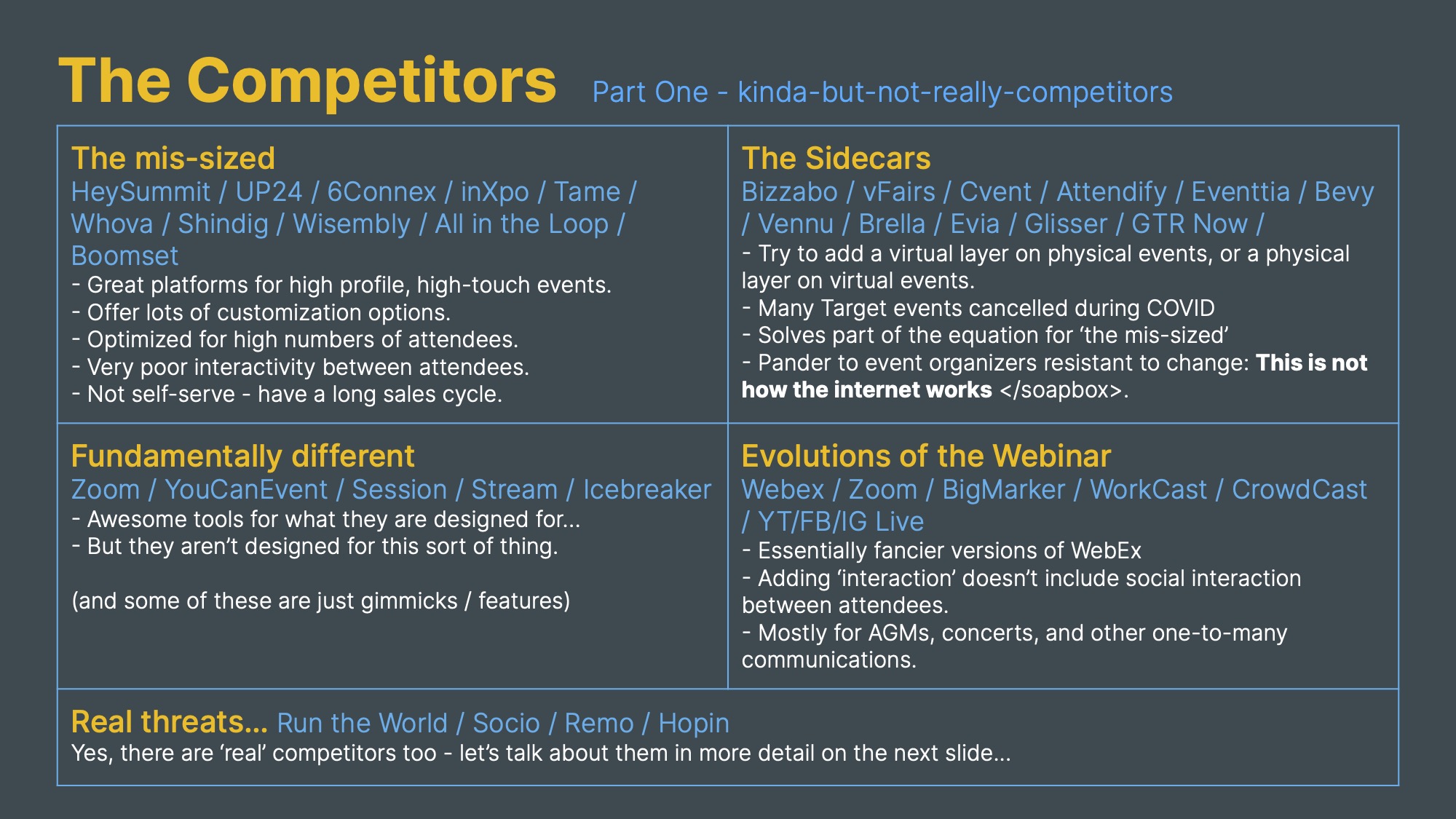In a lot of the pitch deck teardowns, I get stumped by a certain slide, even though I am 99% sure that when a founder uses it to pitch a VC, they will give a little bit of additional context that “unlocks” the slide and helps it make sense.
The specific slide that inspired this post was from Forethought’s Series C deck, which ended up raising $65 million for the TechCrunch Battlefield-winning company, but I’d be lying if I said that this was an uncommon problem.

The issue with this slide is that while it looks very pretty, it doesn’t contain a photo of Forethought’s founders. In addition, it is wedged between two slides about the company’s customers and its value proposition. That left me confused because now there were two ways of interpreting this slide: It’s possible that Forethought was named as one of Forbes’ next billion-dollar startups. Or it has all of the companies on said list as customers and is flexing in the same way that some companies will say “200 of the S&P 500 companies use our product.”
A quick search later confirmed that the former was true — Forethought is on the Forbes list — but if I have to conduct a search to make sense of a slide, that’s not a good sign.
It’s such a great example, though, of a slide that looks good and could work great with just a few words of voice-over. The thing is, though, that while most VC pitch decks are presentation decks, that is far from the only context in which you’ll be using your deck. In fact, there are at least four:
- The teaser deck.
- The send-ahead deck.
- The presentation deck.
- The leave-behind deck.
Let’s talk through the differences and similarities between your pitch decks and take a closer look at what each deck needs to do in each context. I’ll also show how you can avoid having to build and maintain 9,000 different decks.
It turns out that “the perfect deck” doesn’t exist because it is all heavily context-dependent. A deck that works great for a showy pitch competition might include builds and animations, for example, but if you’re having to click your way back and forth through a deck during a VC pitch, you’re going to drive yourself mad clicking past all the animations and reveals. The biggest difference between the various decks, however, is the context for how it is viewed and what the purpose of each deck is.
Not all founders I work with end up with multiple versions of different decks, but it’s helpful to view the deck through a few different lenses to ensure it works in every way it is likely to be consumed.
The presentation deck
When people think “pitch deck,” they typically mean the presentation deck — the slides you will be using when you are presenting your startup in the context of a pitch. This could be in-person at a VC office or virtually via a teleconferencing platform. There are a couple of things that stand out when it comes to presentation decks:
- Use graphics: The most powerful use for a presentation deck is showing with photos, illustrations or graphs things that are hard(er) to convey with words.
- Fewer words: Almost every deck I see is alphabet soup. There’s a problem with that: As soon as the deck goes up on the screen, you lose control over the meeting. Your would-be investors are going to be spending the next crucial seconds or minutes reading what’s on the slides. During that time, they aren’t going to be listening to you, and you don’t really know when they are done reading. That’s just poor storytelling. As a rule of thumb, aim for a maximum of 10 words per slide. Minimum text size 35 points. Literally nobody in the history of pitch decks (me included) has been able to keep an entire deck to 10 words per slide, but be prepared to defend those extra words and why there’s no other way of telling the story.
- No animations or builds: Nuff said, but TL;DR: You want to be able to quickly find a slide you’re looking for. Animations get in the way of that, so get rid of ’em.
- Avoid videos: Some stories really need a video to land, but videos are too unpredictable; you don’t know how good the internet connection is at the VC’s office (you’ll often be on a guest network that may not be as fast as you’d like). People may be dialing in to the meeting. And if you hit “play” on a video, you’re ceding important pitching time, and it’s hard to change direction if you need to. If you absolutely must show a video, make sure it’s very short, doesn’t rely on audio working and that you have a fall-back plan in case you can’t get it to play.
- Have appendices ready: One of the great things about appendices is that the rules above don’t apply as strictly. If you have a wall of long customer testimonials that need to be read, great — stick ’em in an appendix. Same for detailed product or go-to-market strategies, IP strategies or detailed financial spreadsheets. Make a simplified operating plan for your main deck and throw the 90,000-cell spreadsheet in an appendix or — better still — have it available to send to the VCs after the meeting if they are ready to do a deep dive.
The teaser deck
A teaser deck is what I sometimes call the look at me deck. It has three to four slides and really serves the same role that a one-pager would have in days gone by. These days, not a lot of startups use one-pagers anymore, but having something that can be very quickly consumed is helpful. These decks tend to focus on the things that are unique about a startup and may inspire an investor to want to take a closer look. You can use more words on the teaser deck than on your presentation deck, of course, because it’s designed to be consumed separately from your face, voice and body language.
It’s typically only used for startups at the earliest stages, and it will probably include some of the following:
- Team: If you have a truly extraordinary team.
- Traction: If you have any.
- Problem and solution: Often on the same slide, side by side.
- Market size: Unless the market size is “obvious,” but even then, I’d include it for most companies.
- Details about the round: You know, roughly how much are you raising.
These details will serve to get a quick “no” out of investors who aren’t really that interested; it saves them and you a bunch of time. Because this deck is often distributed far and wide, I’d recommend against including much proprietary information here. The purpose of the teaser deck is just to get to your first screening call, and it’s likely that the investors will ask for a full deck at this point — although if they are particularly keen, they may skip that and go straight to the first pitch meeting.
Generally, I’m not a huge fan of teaser decks, and I tend to avoid them; a warm introduction, a meet-and-greet, a quick elevator pitch or a good cold-pitch email does the trick just as well in most cases. The one exception is if your product is particularly visual — this may be because it’s a hardware device or generates some sort of visual output that really helps sell the company you’re building.
The send-ahead deck
At the earliest stages of investments, investors will often ask for a pitch deck as the very first piece of information. I often talk to frustrated founders, who will say something like, “Damn it, the deck doesn’t make sense without the voice-over,” or, “It is so much easier to just explain what’s going on; I hate sending my presentation deck in advance.”
I get the pushback, but it’s also pretty awkward to have to say “no” in your very first interaction with an investor, especially when they are asking for information you’re itching to give them!
In any case — the solution to the conundrum is pretty simple: If you have a deck that doesn’t make sense without a voice-over, then make a deck that does. If you hate sending your presentation deck, then make another deck that works differently.
Good storytelling is all about fitting the message to the medium and the context. To state the obvious: Disneyland, a Disney movie and a Mickey Mouse doll sold in a merchandise shop are all parts of the same story, but they are presented very differently, because they are distinct products that are marketed in ways that work best for the target audience. You’ve got to do the same with your decks.
So what is a send-ahead deck?
- Use yer words: A send-ahead deck can contain more words than you typically would include on a slide you use to present from.
- Mind your audience: No serious, professional institutional investor would forward a pitch deck to another firm or a competing startup, but not all investors are serious or professional. If there is truly sensitive data in your deck, think about what it would mean if a competitor got their paws it.
- Lose the appendices: A lot of the time, appendices are there to help you give additional context and nuance, but that isn’t relevant in this case — your send-ahead deck is just there to paint the broad picture and for an investor to agree to take a meeting.
- Export to PDF: PDFs have the benefit of embedding all fonts and images, so they look the same on all computer systems. The same can not be said for Keynote or PowerPoint files, so keep it simple; only send PDFs.

The above slide is absolutely horrifically bad, but it had to exist for a reason: A lot of the time when I pitched Konf to investors, the pushback would be “but Zoom exists, so … ” the challenge I was facing was that I had a good answer to that particular line of feedback. However, I often didn’t even get a screening call to explain myself.
I introduced the above slide to show off the 36 major competitors I was aware of. (As an aside, TechCrunch’s main events platform, Grip, didn’t even make it to my list, and I now know of half a dozen additional competitors. As you can imagine, at the beginning of a pandemic, the whole virtual events segment became an utter bloodbath). This slide actually helped get me more meetings, because I was able to explain how Konf differentiated itself from the vast majority of the competitors.
The presentation version of this slide, which, sadly, I no longer have a copy of, was far simpler. It just had the category titles (“The mis-sized,” “The Sidecars,” “Webinar 2.0,” etc.) and company logos. That version only had 13 words on it, a world of difference compared to the hideous word soup you see above. It is probably the clearest example I’ve seen of how different a send-home deck can be from a presentation deck.
The leave-behind deck
The final category of deck is also emailed to investors, but it is typically sent after the pitch meeting. Investors know that decks evolve over time, and when you first send a send-ahead deck, it may be weeks until you get a chance to pitch it. The next step after your pitch depends on who was in the meeting, but a lot of the time you first pitch to an associate or a single partner, and the next pitch will be to additional partners, as they get more serious about you as an investment opportunity.
Between your first and second pitch, they will be discussing your company in the firm’s deal-flow meetings. At that point, people who are particularly interested in the deal — either because they love it, hate it or need more info to make up their minds — will probably want to refresh their memories with … you guessed it … your pitch deck.
A lot of founders will just send the presentation deck or the send-ahead deck, but that introduces a problem. The presentation deck is designed to have a voice-over, and your deck may end up in front of someone who didn’t sit in on the pitch. No big deal, perhaps, but controlling your narrative and making sure nobody misunderstands something is the name of the game.
Personally, I like to think of the leave-behind deck as a hybrid between the presentation deck and the send-ahead deck:
- More words: You don’t have to keep their attention on your voice, so you can use that to your advantage to get your point across more comprehensively, using the same deck you created to send ahead.
- More appendices: Now that you’ve pitched your startup to an investor and been through a round of Q&A, you may have used a couple of appendices already, or you may have had some questions that you fielded nicely but didn’t have appendices for yet. Include them or make them, add them to the deck and send it through.
- This is the only time you send appendices! They shouldn’t be in the other decks you share with people.
Boom — all the info they need, all in one handy place.
Some founders prefer to keep the leave-behind deck the same as the presentation deck and just add some annotations to the “notes” field of each slide. Most presentation software has the option to “print with speaker notes,” and you can share those with your would-be investors. It doesn’t look as slick, but if your deck only needs minimal additional context to make sense, this can be an elegant, time-saving workaround.
How do you build multiple decks and keep track of it all?
It’s important that the slides don’t contradict themselves, and slide decks can change often. So how do you ensure they stay in sync when you have multiple sets of information?
I like to keep the presentation deck slides and the send-home deck slides next to each other in the deck. In other words: Page 9 and Page 10 in your slide deck are both labeled with the same page number, but one is the simplified, bolder version that you use for your voice-over, and the other is the (slightly) more detailed version. You will probably find that for a lot of the slides, you only actually need one version, so that simplifies things somewhat.
When you pitch, there are a few tricks you can use. Whatever presentation software you like to use — Keynote, PowerPoint, Google Slides — probably has a feature to “hide slide during presentation” or “skip slide in presentation mode.” Use that to tag all your more complicated slides, and when you present, you never see them.
Another option is to save the deck as your presentation deck and delete all the slides you don’t need. It means there’s less chance of something going wrong (i.e., you accidentally showing the more detailed slides), and as long as you only ever make edits in the master deck, you should be fine.
When you export the deck, I often recommend exporting all the slides, just deleting the presentation slides from the PDF, leaving the ones you want to include. On Macs, you can use Preview to quickly delete pages out of a PDF, and on both Mac and Windows, Adobe Acrobat gives you the option to delete slides you don’t need easily.
So, do you need multiple decks?
As I mentioned, when I work with pitch coaching clients, we end up creating two separate decks about half the time: a presentation deck and a leave-behind deck that is customized to each VC, including only the appendices that are needed and leaving the others out. The send-ahead deck is the same as the leave-behind deck, but without appendix pages at the end.
Do you need two different decks, though? It depends; if you can make a single deck that is clean and simple enough to not be distracting when you’re using it as a presentation deck, yet detailed and contextualized enough to be consumable on its own, you probably just need the one. But every startup is different, and some founders need a few additional words to get the point across. In general, if you can get away with creating and maintaining just one deck, that’s great, but don’t get too hung up on it. The target audience and modes of consumption are different enough that sometimes, two is better than one.































Comment